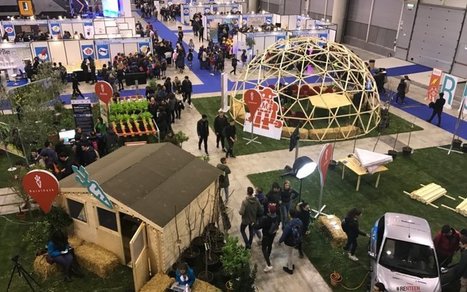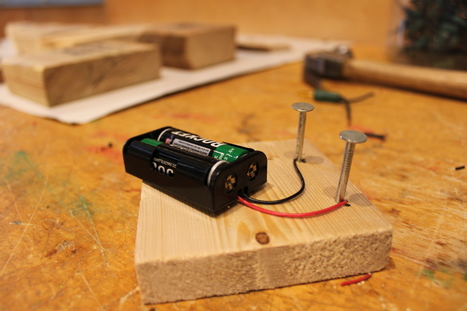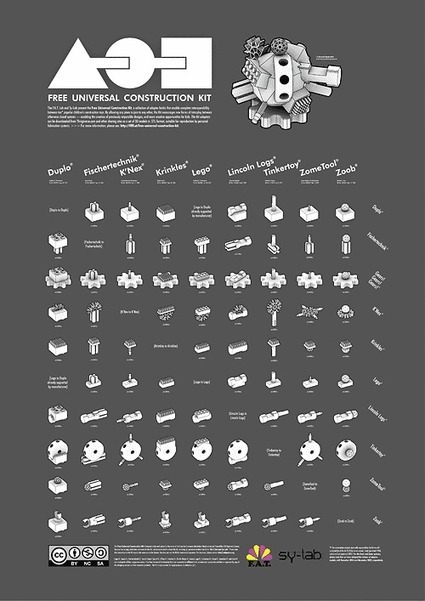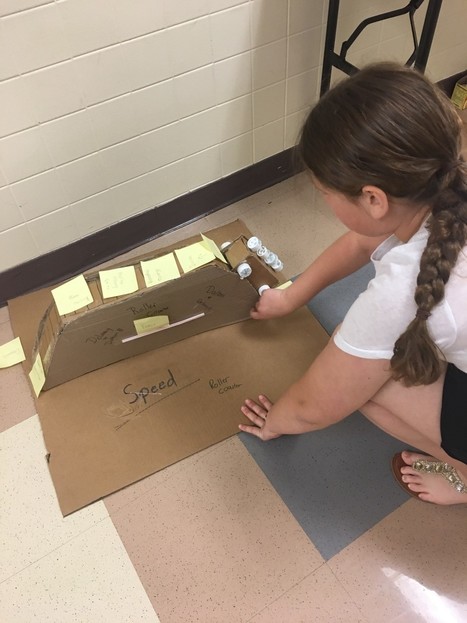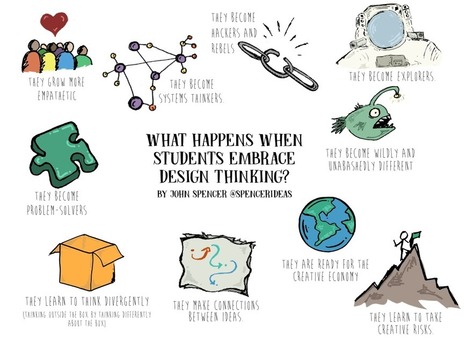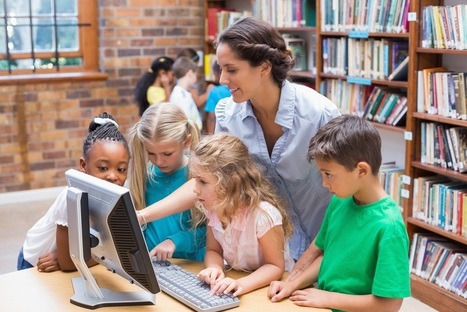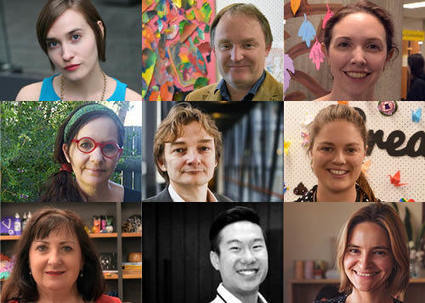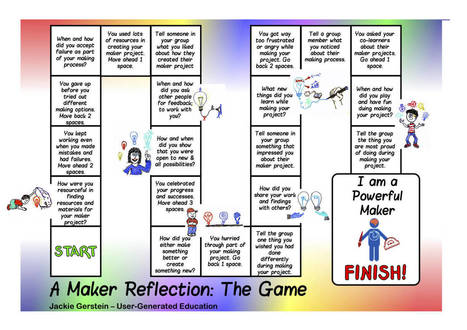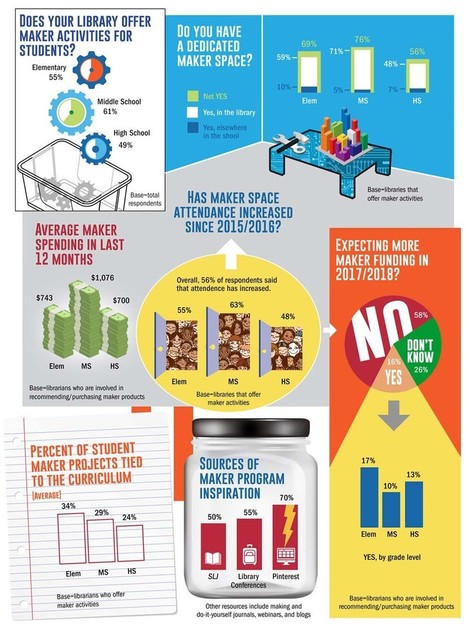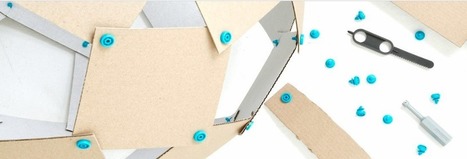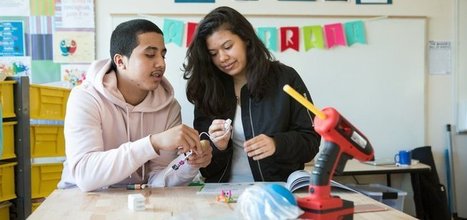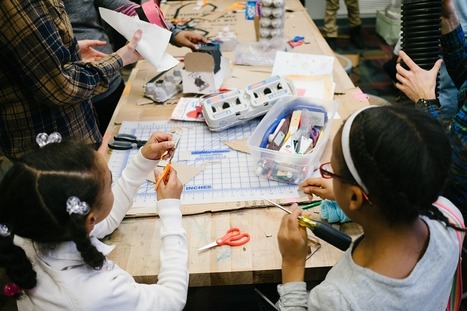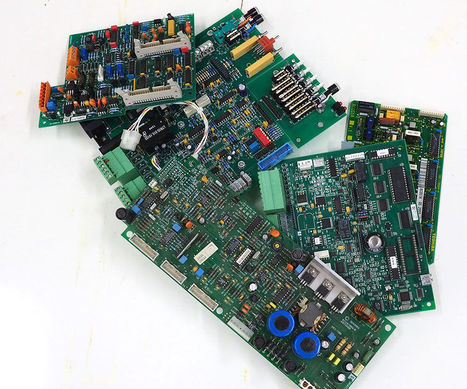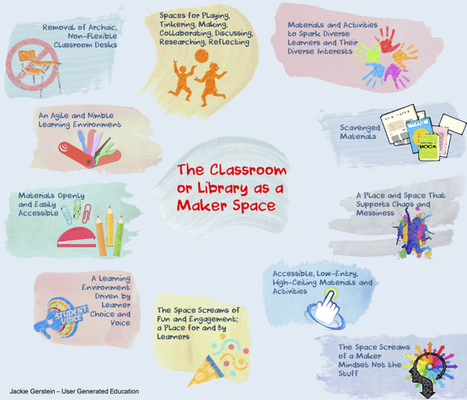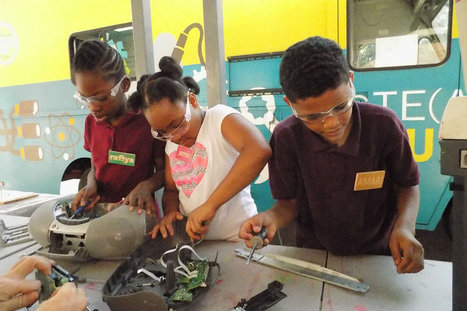 Your new post is loading...
 Your new post is loading...
100,000 visitors and over 700 projects from over 60 countries came to Maker Faire Rome, a faire that's been nicknamed Maker Faire Europe.
Makerspace, Standards and a Look at Computational Thinking – Michael Gorman
As you might know, I believe all transformative practices must be based in the standards. These standards must include both content and process standards (4C’s). Too often, I see wonderful activities that engages students… but also see important standards that could have been incorporated not present in the activity.
The idea behind the Makers Movement includes allowing students to imagine, envision, create, innovate, play, formatively learn, experiment, collaborate, share, and most of all dream of possibilities. The idea of making is not a new concept. In fact, the art of making is at the root and mixed into to the very fabric of our culture. I believe that the amazing innovation we have seen in this country is due to a Maker mentality. We have long been a culture set on dreaming up possibilities, and then taking the action to make it happen. The initial growth of technology has somewhat taken some of our creativity and produced consumption based thinking. We are now past the initial way of thinking, and the Makers movement allows people to finally use the technology to create and make. As we reflect on this… how are you using the Makerspace idea to engage students in content standards while facilitating and assessing process skills?
Dear Gerrit. You and I have on some occasions discussed the future curriculum of pre-school teachers in Europe and especially on how kindergartens and makerspaces can use the possibilities of the Internet. Here is an open answer with some reflections on the subject. You are leading the Erasmus+ project, Mini-Maker, where I take part. Not all users of this blogpost might know the project, so just a few words on it. The goal is to develop a curriculum for a course for pre-school teachers in Europe on digital media competences. Makerspaces play an important part in the development of this future curriculum. One can follow the project on among others this website (http://mini-maker.de/en/#home).
My question to you and me is at the moment like this: What should the pre-school teacher know and be able to do when he or she together with the children in a makerspace situated in a kindergarten start to use the internet and its possibilities for communication, play and production?
Circuit Blocks exist in many different forms throughout museums around the world. A circuit block is a set of components, switches and power sources that can be tethered together to allow people to explore electricity in a safe and easy manner. We have been building and facilitating circuit exploration for the past several years at the Children’s Museum of Pittsburgh. Circuit Blocks have become a staple activity in MAKESHOP. We don’t buy our circuit blocks from some special museum store. We make them ourselves. All of the Teaching Artists in MAKESHOP have their own distinct style of circuit block; some are more refined than others. All of the Circuit Blocks start with the same set of tools and materials. The following instructions will give you a general idea of how to create a simple power source block and a component block.
F.A.T. Lab and Sy-Lab are pleased to present the Free Universal Construction Kit: a matrix of nearly 80 adapter bricks that enable complete interoperability between ten* popular children’s construction toys. By allowing any piece to join to any other, the Kit encourages totally new forms of intercourse between otherwise closed systems—enabling radically hybrid constructive play, the creation of previously impossible designs, and ultimately, more creative opportunities for kids. As with other grassroots interoperability remedies, the Free Universal Construction Kit implements proprietary protocols in order to provide a public service unmet—or unmeetable—by corporate interests.
The Free Universal Construction Kit offers adapters between Lego, Duplo, Fischertechnik, Gears! Gears! Gears!, K’Nex, Krinkles (Bristle Blocks), Lincoln Logs, Tinkertoys, Zome, and Zoob. Our adapters can be downloaded from Thingiverse.com and other sharing sites as a set of 3D models in .STL format, suitable for reproduction by personal manufacturing devices like the Makerbot (an inexpensive, open-source 3D printer).
In recent years, libraries have broadened their scope of offerings to the local community to involve more making activities like 3-D printing and sewing. Some libraries even have a facilitator for maker projects.
At Millvale Community Library in Pennsylvania, maker program coordinator Nora Peters saw an opportunity to better connect the activities of the maker space with the library’s mission to promote literacy. So, she set out to build a bridge between making and reading by creating maker activities for children’s books.
Peters creates project instructions that tie into the theme of a children’s book. She prints the instructions on a 5 x 7 sticker that affixes to the front of the book. Because Millvale serves a lower-income community, she also keeps materials low-tech.
If you attend the live session, you’ll be emailed a CE certificate within 24 hours of the edWebinar. If you view the recording and would like a CE certificate, join the SLC @ the Forefront community and go to the edWebinar Archives folder to take the CE quiz.
A successful school makerspace needs an enthusiastic maker community, school-wide participation, and staff support. How do you build this type of learning at your school?
In this edWebinar, Diana Rendina, Media Specialist and Writer, Tampa Preparatory School in Tampa, FL, will describe step-by-step how to introduce challenge-based learning into your school library makerspace. Her presentation will:
Walk through various real-world design challenges
Address common questions and concerns
Offer practical advice for implementing challenge-based learning in the makerspace
There will be time to ask Diana your questions after her presentation.
edWebinar Bonus! Door prizes will be given away to three lucky attendees of this live event!
Join us to become empowered to go beyond the basics and to draw from an arsenal of proven methodologies for designing challenges for your students’ learning. K-12 school librarians and classroom teachers across disciplines who are interested in the school makerspace are invited to attend this interactive session.
Technology is changing everything in our lives . . . but what does this mean for the future of libraries? One librarian, Ciro Scardina, shares his thoughts.
When kids make they acquire knowledge and competencies in context rather than in isolation from opportunities to make meaning and sense. Sometimes they learn to make for the sheer joy of making and…
Making Isn’t a “Soft Skill”
I believe that creative thinking is as vital as math or reading or writing. There’s power in problem-solving and experimenting and taking things from questions to ideas to authentic products that you launch to the world. Something happens in students when they define themselves as makers and inventors and creators.
Librarians and media specialists are in a unique position within schools, since they are very often the person responsible for introducing students to new technologies, and are also on the front lines when it comes to connecting students to meaningful sources for research.
Today’s students have never known a world without the smartphone or tablet, and many of them have been using these devices independently since infancy. The answers to their questions have never been more than a click of a button away. In this brave new world of technological innovation and free-flowing information, librarians are now tasked with teaching these digital natives how to navigate these waters with discernment, while still taking full advantage of the opportunities these tools afford them.
For me, one of the most powerful pieces of the Maker Movement is that it is based on the belief that regardless of race, gender or even age, there is something in it for everyone. Makerspaces in K-12 have had a profound impact on education, but for me, it also has had a profound impact on myself as a parent, and relationship building with my son. Every spring, since my son has been a toddler, I have prepared a Pinterest board with maker activities for the summer that he and I would be able to complete together. Throughout the spring, we gather and order all necessary materials, this way on the very first day of summer, we can hit the ground running. ‘Making’ is something that is not a focus in his school, so it provided us with the perfect opportunity to invent, explore, experiment and create at home during the summer months.
Hey Makers!
MakerJam 2017 is fast approaching: June 16-18th weekend is a little over a week away!
We wanted to clear up any questions you may have about participating in the jam.
If you want more information, you can visit our various help pages, linked in the sidebar!
Yeah, how do I participate in MakerJam, anyway?
1. Make something, anything.
2. Share it with us.
That’s really it! But we can break it down a bit:
How do I make? What can I make? Where do I go? What are the RULES?
The only rule is that there are no rules.* You can make anything, anyhow, anywhere.
There is, however a theme:
The MakerJam 2017 theme will be released on Thursday, June 15th at 2:00PM EST.
The theme is meant to be a launching pad for your creativity, giving makers a place to start and draw inspiration from, and to loosely unify every participant as part of this year’s collective MakerJam movement.
|
Our maker community is just as important as our new larger venue. To commemorate the launch of the new Makerspace we asked prominent members of our maker community why the Makerspace is important to them
Being a librarian is not an easy job, and it’s not because we occasionally have to clean up vile messes. It’s not easy because, like Steven Assarian explained in his article, “As a Business Librarian, I Help People Find Their Passion,” people sometimes come to us at a crossroads. They’re afraid of making a mistake that may put their lives in turmoil. Heck, sometimes their lives are already in turmoil. Librarians take on that chaos; we have no choice but to face down the power, joy and suffering both, that people bring into our space. That’s the emotional labor of librarianship. It’s not something we often talk about to the public, or even that much to each other. But it’s real, it’s hard, and it’s important. Thank you for letting me share a little about it.
Jackie Gerstein is an experienced educator who has been working as a classroom teacher and pre-service teacher trainer for years. With a background in experiential learning, Gerstein is excited about current trends in education that have more people excited to try project-based learning, maker education and other approaches that let students get hands-on with their learning.
She hopes all the excitement turns into robust, meaningful change in how mainstream teachers educate. To do that, she says it’s crucial that teachers not only focus on the materials and tools of a maker activity, but also carefully frame it and reflect upon it to make sure learning happens.
“If we don’t create a process of reflecting and framing them, then we are leaving learning up to chance,” Gerstein said on a panel about makerspaces hosted at the International Society of Technology in Education (ISTE) conference.
Old-fashioned board games and puzzles are what first drew students at a Jacksonville, NC, middle school into the library’s maker space. Now they’re experimenting with Snap Circuits and coding robots. At a rural school in Maryland, library participation has increased because of activities such as 3-D printing and Tinkercad design—especially among girls.
Meanwhile, at an elementary school in Iowa City, IA, students work at a “tinkering table” in the library, taking apart old equipment and using scrap pieces to make new creations, such as jewelry and robots.
There is growing interest from schools in the Maker Movement and Maker Education but with this have come some subtle misunderstandings about what it is all about. For one the modern maker movement is all about the mindset of the maker rather than developing a set of specific skills for making. The second confusion stems from a belief that the maker movement is all about the tools and the makerspace and that as such it involves large budgets.
News, voices and jobs for education professionals. Optimized for your mobile phone.
The Maker Revolution celebrates the creation of new devices and the modification of existing ones - the transition from a consumer buying goods to eventually having a major part in their creation. The Maker Revolution places strong emphasis on free (as in speech) sharing of designs, code and ideas. Learning is self-motivated and usually just for the fun of it.
Below is a timeline of what we think are some pivotal moments in the Maker Revolution - these might be the founding of important companies; the release of game-changing hardware; and the launch of maker-enabling services. It's interesting to see the shifting of attention among the interest categories
THE POSTER
A preview is below. If you'd like to download the full-size image for printing you can grab it here.
https://core-electronics.com.au/media/kbase/210/maker-revolution-full-size.pdf
The Children’s Museum of Pittsburgh, in partnership with the Institute for Museum and Library Services, has released a report sharing best practices and guiding principles for makerspaces.
Research into the meaning and value of maker learning has been a focus of The Children’s Museum of Pittsburgh from the first steps they took to start developing ideas for MAKESHOP in 2010. In the years since, MAKESHOP has become a national exemplar among youth and family makerspaces and the Children’s Museum has emerged as a leading voice for the thoughtful and informed advancement of maker learning.
With stores like Radio Shack disappearing, it is getting hard to find simple electronic components. The web, particularly eBay, has been a great help, but shipping can get costly. Consumer electronics, like VCRs and Microwave Ovens can be a source of parts, but consumer electronics tends to very highly integrated. Many parts are special made, or so specialized they are not useful.Lately, however, the recycling move has produced a wonderful source of high-grade electronics. Check around you area for electronic recycling centers. These businesses take electronic equipment from companies and take responsibility for bring the material into the recycling stream. They typically disassemble the equipment separating the various metals and other valuable contents into various bins for sale to refiners. The circuit boards get thrown into a large container and are usually shredded for reprocessing.Commercial equipment is built to a much higher standard than consumer electronics. Cost is not s
A classroom or library can be transformed into its own makerspace, a space for powerful student learning by doing the following realistic and workable actions:
Removal of Obsolete, Non-Flexible Classroom Desks (including the traditional teacher’s desk)
Spaces for Playing, Tinkering, Making, Collaborating, Discussing, Researching, Reflecting
An Agile and Nimble Learning Environment
Materials Openly and Easily Available
Materials and Activities to Spark Diverse Learners and Their Diverse Interests
Scavenged Materials
A Place and Space That Supports Chaos and Messiness
Accessible, Low-Entry, High Ceiling Materials and Activities
A Learning Environment Driven by Learner Choice and Voice
The Space Screams of Fun and Engagement
The Space Screams of a Maker Mindset Not the Stuff
The essential reference book for makers. Connect almost anything to your Arduino compatible board!
A growing number of public schools in low-income areas have begun using "mobile makerspaces" housed in refurbished school buses and other vehicles to expose students to the joys of science, technology, engineering, and math (STEM). The rolling initiative – which would make Ms. Frizzle, driver of "The Magic School Bus" proud – follows a broader trend of cash-strapped districts turning to mobile classrooms to provide students with opportunities too costly for individual schools to afford.
These traveling miniature science and engineering labs, inspired by the modern do-it-yourself maker movement, provide disadvantaged students with hands-on experience in areas such as coding, 3D printing, and video game design. By exposing underserved students to careers that they may not otherwise have been aware of, even if just for a day, advocates hope to increase the number of low-income students in STEM careers, where they are traditionally underrepresented.
|
 Your new post is loading...
Your new post is loading...
 Your new post is loading...
Your new post is loading...





